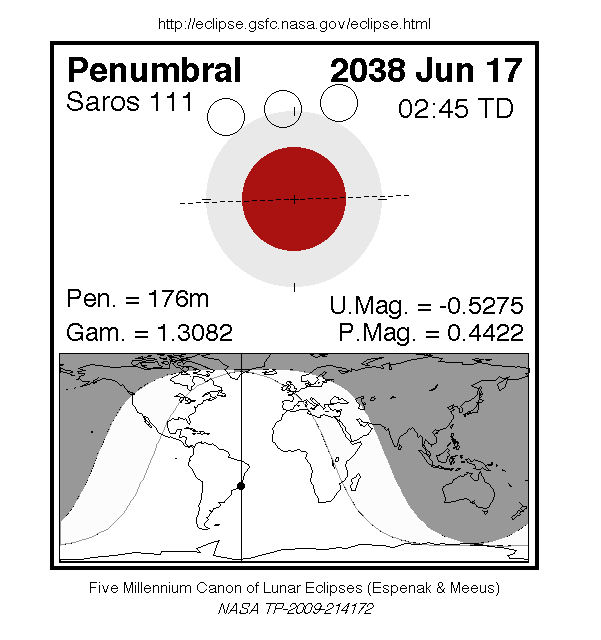A penumbral eclipse of the Moon occurs on Thursday 17 June, 2038 UT, lasting from 01:15–04:11 UT. This very subtle penumbral eclipse will be essentially invisible to the naked eye; though it will last 2 hours and 56 minutes, just 44% of the Moon's disc will be in partial shadow (with no part of it in complete shadow). The full Moon itself will be visible in most of North America, South America, Europe, and Africa.
The timings of the eclipse are as
follows. You will be able to see the
eclipse if the Moon is up as
seen from your location; but note that this penumbral
eclipse will be very difficult to see in practice:
| Penumbral eclipse begins: |
01:15:23 UT |
| Maximum eclipse: |
02:43:38 UT |
| Penumbral eclipse ends: |
04:11:43 UT |
During this eclipse the Moon will be just 2 days past perigee, making it fairly large.
At maximum eclipse it will be 0.550° in apparent
diameter, which is 3.6% larger than average.
The statistics page has information on the ranges of the sizes of
the Sun and Moon, and the Moon data page displays detailed
information on the Moon's key dates.
Interactive Map
This map shows the visibility of the eclipse at maximum eclipse,
when it will be visible within the bright area on the map. Note that
the map is approximate, and if you
are near the edge of the area of visibility, the moon will be very close
to the horizon and may not be practically visible.
You can use the zoom controls to zoom in and out, and pan to
see areas of interest. The green marker in the centre shows where
the Moon will be directly overhead at maximum eclipse.
The interactive map is currently not available.
Overview Map
This map sourced from NASA Goddard Space flight Center: GSFC Eclipse Web SiteGSFC Eclipse Web Site
The primary source of all the information on eclipses presented here at Hermit Eclipse. (NASA Goddard Space flight Center)
shows the visibility of the eclipse. (Click on it for the
full-sized version.)
Eclipse Season and Saros Series
This eclipse season contains 3 eclipses:
This is the 68th eclipse in lunar Saros series 111.The surrounding eclipses in this Saros series are:
This Saros series, lunar Saros series 111,
is linked to solar Saros series 118. The
nearest partner eclipses in that series are:
Eclipse Parameters
| UT Date/time (max) | 02:43:39 on 17 Jun UT |
TDT Date/time (max) | 02:45:02 on 17 Jun TDT |
| Saros Series | 111 |
Number in Series | 68 |
| Penumbral Magnitiude | 0.4422 |
Central Magnitiude | -0.5275 |
| Gamma | 1.3082 |
Path Width (km) | |
| Delta T | 1m23s |
Error | ± 0m18s (95%) |
| Penumbral Duration | 2h56m |
Partial Duration | |
| Total Duration | |
| |
| Partial Rating | |
Total Rating | |
| Sun Distance | 151966408 km (100.8%) |
Moon Distance | 367953 km (23.0%) |
| Sun Diameter | 0.525° |
Moon Diameter | 0.541° - 0.550° |
| Perigee | 15:27 on 14 Jun UT |
Apogee | 12:56 on 26 Jun UT |
| Contact p1 | 01:15:23 on 17 Jun UT |
Contact p2 | |
| Contact u1 | |
Contact u2 | |
| Max eclipse | 02:43:38 on 17 Jun UT |
| Contact u3 | |
Contact u4 | |
| Contact p3 | |
Contact p4 | 04:11:43 on 17 Jun UT |
Note that while all dates and times on this site (except
where noted) are in UT, which is within a second of civil time,
the dates and times shown in NASA's eclipse listingsGSFC Eclipse Web Site
The primary source of all the information on eclipses presented here at Hermit Eclipse. (NASA Goddard Space flight Center)
are in the TDT timescale.
The Sun and Moon distances are shown in km, and as a
percentage of their minimum - maximum distances; hence 0%
is the closest possible (Earth's perihelion, or the
Moon's closest possible perigee) and 100% is
the farthest (aphelion, the farthest apogee).
The statistics page has information on the ranges of sizes
of the Sun and Moon, and the Moon data page displays detailed
information on the Moon's key dates.
Data last updated: 2015-06-21 22:11:46 UTC.

